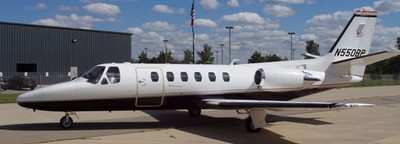ATC, Radar Records Indicate Steep Climb, Descent Prior To
Impact
 The National Transportation Safety
Board issued an update Thursday on its investigation of the crash
involving a Cessna Citation II 550 business jet that occurred last
month.
The National Transportation Safety
Board issued an update Thursday on its investigation of the crash
involving a Cessna Citation II 550 business jet that occurred last
month.
As ANN reported, on June 4,
2007, at 4:10 PM Central Daylight Time, a Cessna Citation II 550
business jet, N550BP (shown below), registered to Air Toy, Inc.,
and leased from Marlin Air, Inc., as a 14 CFR Part 135 air medical
flight for the University of Michigan Health System, crashed into
Lake Michigan shortly after takeoff from General Mitchell
International Airport in Milwaukee, WI. Both flight crewmembers and
all four passengers were killed. Instrument meteorological
conditions prevailed and an instrument flight rules flight plan was
filed for the 42-minute flight from Milwaukee to the airplane's
home base in Willow Run Airport, Ypsilanti, MI.
AIR TRAFFIC CONTROL INFORMATION
A review of air traffic control (ATC) voice communications and
recorded radar data revealed that the flight crew reported an
emergency and their intention to return to MKE shortly after
takeoff. During those communications, one of the flight crewmembers
reported that they had experienced a runaway trim. In a later
transmission, a pilot was heard telling the other pilot to hold the
airplane's controls so that he could pull circuit breakers.
Initial examination of the radar data shows the airplane
departing MKE and executing a climbing right turn to a northeast
heading. The airplane's initial climb lasted for approximately one
minute at which time the airplane leveled off for approximately 16
seconds at a pressure altitude of 3,900 feet. The airplane then
began another climb at 1,300 feet per minute. This climb lasted for
about 30 seconds at which time the airplane's pressure altitude was
4,400 feet. The radar data then shows the airplane in a descending
left turn for the remaining 69 seconds of the data. The average
descent rate during this period was 2,260 feet per minute. The last
radar return shows the airplane at 1,800 feet pressure altitude.
The wreckage debris field was located less than 0.2 nautical miles
southeast of the last radar return.
COCKPIT VOICE RECORDER
The cockpit voice recorder (CVR) was located and sent to the
NTSB Vehicle Recorders Laboratory in Washington, DC. The CVR's case
was severely damaged, but information from the accident flight
could be extracted. The information indicated that the flight crew
had difficulty with the directional control of the airplane shortly
after takeoff.
A CVR Group was formed, and a complete transcript of the
30-minute recording is being developed.
WRECKAGE RECOVERY AND EXAMINATION
The main wreckage field was located near the last radar hit in
about 60 feet of water depth. Although the CVR was recovered by a
US Navy contractor, the remainder of the wreckage was recovered by
other contracted divers and taken to a facility near Poplar Grove,
Illinois. The subsequent wreckage examination performed by the NTSB
revealed pitch, roll, and yaw trim settings that were not in the
neutral position. The Board will continue to assess the
significance of these settings. Various flight control components
and avionics units have been harvested for further testing and
examination.
OTHER ACTIVITY
The investigation team has secured the maintenance records for
the airplane. A preliminary review revealed that the autopilot
engage relay was replaced in November 2006. No recent unresolved
discrepancies were noted. Investigators will continue to review
documents.

An aircraft performance study is being developed with
information from the CVR, radar data, and flight control positions
to describe the motions of the airplane during the accident flight.
Additionally, plans are being developed to utilize a Cessna
Citation II flight simulator to further explore possible failure
scenarios.
Avionics units, including the airplane's Enhanced Ground
Proximity Warning System (EGPWS) will be examined in order to have
any potential non-volatile memory (NVM) extracted. These NVM data
may provide clues to the motion of the airplane during the accident
flight, and/or any equipment failures that may have occurred.
John Brannen of the NTSB's North Central Regional Office in West
Chicago, Illinois, is the Investigator-in- Charge of this incident.
Parties to the investigation include the Federal Aviation
Administration, Cessna Aircraft Company, Marlin Air, Inc., Pratt
& Whitney Engines, and Honeywell. The NTSB case number is
CHI07MA160.
 SpaceX to Launch Inversion RAY Reentry Vehicle in Fall
SpaceX to Launch Inversion RAY Reentry Vehicle in Fall Aero-News: Quote of the Day (04.23.24)
Aero-News: Quote of the Day (04.23.24) Aero-News: Quote of the Day (04.20.24)
Aero-News: Quote of the Day (04.20.24) ANN's Daily Aero-Linx (04.20.24)
ANN's Daily Aero-Linx (04.20.24) Aero-News: Quote of the Day (04.21.24)
Aero-News: Quote of the Day (04.21.24)




